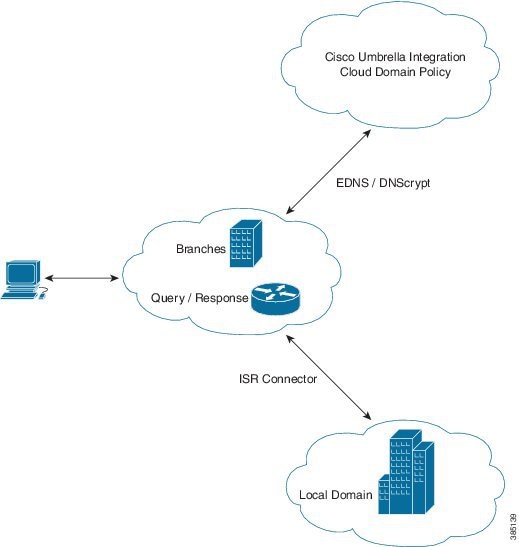Cisco High Availability (HA) enables network-wide protection by providing fast recovery from faults that may occur in any
part of the network. With Cisco High Availability, network hardware and software work together and enable rapid recovery from
disruptions to ensure fault transparency to users and network applications.
The unique hardware and software architecture of the router is designed to maximize router uptime during any network event,
and thereby provide maximum uptime and resilience within any network scenario. The Cisco Umbrella Integration is enhanced
to meet High Availability criteria on Cisco ASR 1000 Series platform. The Cisco ASR Series Router supports the following High
Availability options:
-
Dual IOSD
-
Dual RP/FP
-
Interchassis HA
Dual IOSD
In the dual IOSD scenario, the umbrella related configuration syncup happens automatically. However, the device registration
and the DNSCrypt keys generation happens only on active IOSD processors. The configuration objects take the path from active
device iosd->fman-rp->fman-fp->cpp. The standby IOSD is connected to backup fman-rp which is not connected to fman-fp. The objects from the standby iosd/fman-rp are in the standy fman-rp database.
Once the standby processor is active, the device registration and DNSCrypt keys exchange are enabled. The device-ID is same
for both active and the standby processor. However, the DNSCrypt keys generated are different. When the active IOSD/fman-rp
failsover, the newly active IOSD/fman-rp downloads the new keys to the CPP.
Any DNS response based on the old processor has the old key index so that it can be decrypted after the failover. Any DNS
requests after the failover should start using the new keys seamlessly without any disruption. When the active router becomes
unavailable for a reason, the standby router takes over the processing.

Note |
Dual IOSD feature is supported only on Cisco ASR 1002 and 1004 Series devices.
|
Dual RP/FP
In the multiple Route Processor (RP) and Forwarding Plane (FP) scenario, multiple RPs or FPs are available. The active RP
is the one connecting to all the FPs and the standby-RP is idle. Only one RP and one FP are active at any time.
In the case of a FP-failover to a redundant FP, there is no disruption as the same objects based on the active RP are programmed
on all the FPs and the redundant FP takes over seamlessly.
In the case of a RP failover, the active RP pushes all umbrella config objects along with new deviceid and dnscrypt key objects
to active FP similar to dual IOSD processing.

Note |
Multiple RP and FP high availability feature is supported from Cisco ASR 1006 Series onwards.
|
Interchassis HA
The Interchassis High Availability feature is also known as the box-to-box redundancy feature. Interchassis High Availability
enables the configuration of pairs of routers to act as backup for each other. This feature can be configured to determine
the active router based on several failover conditions. When a failover occurs, the standby router seamlessly takes over and
starts processing call signaling and performing media forwarding tasks.
You can configure pairs of devices to act as standbys for each other. Redundancy is configured on an interface basis. Pairs
of redundant interfaces are known as redundancy groups (RGs). Redundancy occurs at an application level and does not require
a complete physical failure of the interface or device for a switchover of the application to occur. When a switchover occurs,
the application activity continues to run seamlessly on the redundant interface.
Redundant devices are joined by a configurable control link and a data synchronization link. The control link is used to communicate
the status of devices. The data synchronization link is used to transfer stateful information from Network Address Translation
(NAT) and the firewall and synchronize the stateful database. The pairs of redundant interfaces are configured with the same
uniqueID number known as the redundant interface identifier (RII).
In the case of umbrella, the two devices independently register with the portal and get two unique device-IDs, generates two
different DNSCrypt keys and pushes them to the CPP. Each of the device is operating independently as a stand alone device
with the only modification to take care of asymmetric routing. When there is a failure in one of the chassis, the other chassis
takes over. Note that since there is no syncup between devices, any messages received from the failed device cannot be decrypted
on the active device. However, these messages can be encrypted with the keys of the new active chassis.

Note |
Interchassis HA feature is supported only on Cisco ASR 1001 to 1013 Series devices.
|





 Feedback
Feedback